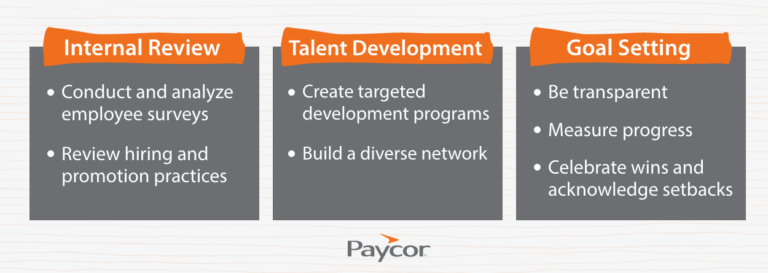Succession planning is a core component of any business strategy. And in today’s talent landscape, effective succession planning has to be inclusive. HR can use this process to achieve DE&I goals, drive company-wide innovation, and take talent development to the next level.
What Is Inclusive Succession Planning?
If you want your organization to reach long-term goals, its success can’t depend on a single person or even a single generation of employees. What happens when someone retires or goes on maternity leave? Would one person’s departure wreak havoc on your quarterly goals? Leaning too hard on your current team members – including your most loyal high performers – leaves your company vulnerable.
Inclusive succession planning is one of the best ways to set and work toward DE&I goals for leadership. This process expands your talent pool so you can develop a more diverse leadership team. It includes upskilling your team, promoting internally, and making sure your hiring practices align with your long-term strategy.
Setting DE&I Goals for Leadership
As you define your diversity and inclusion goals, make sure they’re measurable, achievable, and aligned with your organization’s values. DE&I isn’t just a box for companies to check. It’s an overarching perspective that can and should inform your corporate strategy. Some potential goals could be:
- A leadership team with similar demographics to your entire workforce, by percentage
- Internally promoting top talent to leadership positions
- Increasing employee participation in leadership development programs
- Boosting the percentage of minority candidates interviewed for manager roles
- Implement unconscious bias training for all hiring managers
- Partner with ERGs to offer development and mentorship opportunities for more diverse candidates
Your DE&I goals for leadership might also change over time. For example, your team will get more diverse as you build a more inclusive culture. That will change what it means for your leadership team to match frontline workers’ demographics. Make sure you reassess your strategy regularly to keep it aligned with company values.
Working Toward Inclusive Succession Goals
Inclusive succession planning is a long-term commitment. You won’t develop new talent overnight. Instead, HR should develop an action plan that accounts for gradual changes to the company as a whole. Every company’s succession plan is unique, but many of them include these steps:
Conduct Employee Surveys
Evaluate the demographics of your current frontline and leadership teams. Do the percentages of each demographic roughly match up? If not, why not? This could point to a skills gap or a larger issue in the industry. You could also conduct a survey to get input from employees. Consider asking about their experiences with the current leadership team, and whether they feel they have opportunities for career advancement.
Analyze Data
Once you collect enough information, analyze it for insight into the state of your company. If there’s a noticeable difference in the demographics of leadership vs. frontline workers, what’s causing it? If employees say they have plenty of career development opportunities, where is that support coming from? Look for trends and use them to draw conclusions. Use your findings to inform short- and long-term DE&I goals.
Review Hiring Practices & Promotion Criteria
Work with your HR team and hiring managers to understand hiring criteria. Do you take a skills-based or role-based approach? Do you require entry-level workers to have college degrees? Look for ways to expand your talent pool without sacrificing quality.
At the same time, review your company’s criteria for promoting frontline workers to leadership roles. Do you offer talent development opportunities? Do your employees ever get face time with executives? This step can help you identify and work through implicit bias.
Create Targeted Development Programs
Work with managers to identify top performers from diverse backgrounds. (You could also partner with ERGs to accomplish the same goal.) Then, offer them opportunities that focus on leadership development. That could include joining a mentorship program, attending a special training, or taking on a stretch assignment.
Build a Diverse Network
Recruiting is at the core of succession planning. While you develop high-potential team members to become managers, you should also look for new talent to replace them when they get promoted. Expand your talent pool by building relationships with a wider community. You could reach out to universities, professional organizations, or special interest groups. Be sure to ask your team members for suggestions!
Be Transparent
Announce your commitment to inclusive succession planning. This invites employees and customers to buy into the effort and help you achieve inclusion goals. It also sends the message that you’ll be accountable to them throughout the process.
Measure Progress
Celebrate wins and be honest when you fall short. Growth isn’t always linear, but it can always be a learning experience. If your company can’t meet your DE&I goals, HR should closely evaluate what’s getting in the way. You may need to change your strategy or update your goals to be more realistic.

Benefits of Inclusive Succession Planning
Think of it like this: a strong leadership team should represent your entire workforce. DE&I isn’t a checkbox, it’s an overarching perspective that informs your business strategy. When you implement an inclusive succession plan, you set your organization up for long-term success.
Diverse teams – especially leadership teams – have several benefits. For one thing, they tend to be more profitable (McKinsey). They’re also more innovative because they have a wider range of strengths.
Inclusive succession planning also drives HR goals like recruiting. Nearly 80% of the workforce want their employer to value diversity (CNBC). Publicizing your diversity, equity, and inclusion goals can expand your talent pool and become a positive feedback loop.
How Paycor Helps
Inclusive succession planning is more than a best practice – it’s a business imperative. This strategy empowers leaders to drive profitability, employee engagement, and long-term success. By investing in your team, you invest in your company’s future.
Paycor’s Talent Development software helps HR upskill top talent. Features like our Recognition Tool boost employee engagement, and preloaded coaching templates create a culture of feedback. Learn how to support diverse team members through every step of the employee life cycle, from hire to retire.










